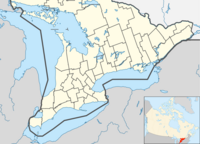St Thomas, Ontario
| St. Thomas | |
|---|---|
| City (single-tier) | |
| City of St. Thomas | |

St. Thomas City Hall, designated a National Historic Site
|
|
 |
|
| Coordinates: 42°46.5′N 81°11′W / 42.7750°N 81.183°WCoordinates: 42°46.5′N 81°11′W / 42.7750°N 81.183°W | |
| Country |
|
| Province |
|
| County | Elgin |
| Settled | 1810 |
| Incorporated | 1852 (Village) |
| 1861 (town) 1881 (city) |
|
| Government | |
| • Mayor | Heather Jackson |
| • Governing Body | St. Thomas City Council |
| • MPs | Karen Vecchio (CPC) |
| • MPPs | Jeff Yurek (OPC) |
| Area | |
| • Land | 35.52 km2 (13.71 sq mi) |
| Elevation | 209.10 m (686.02 ft) |
| Population (2011) | |
| • Total | 37,905 |
| • Density | 1,067.3/km2 (2,764/sq mi) |
| Time zone | EST (UTC-5) |
| • Summer (DST) | EDT (UTC-4) |
| Postal code span | N5P, N5R |
| Area code(s) | 519 and 226 |
| Highways |
|
| Website | http://stthomas.ca/ |
St. Thomas (2011 population 37,905) is a city in Southwestern Ontario, Canada. It gained its city charter on March 4, 1881. The city is also the seat for Elgin County, although it is independent of the county. It is part of the London census metropolitan area.
The city, located at the intersection of two historical roads, was first settled in 1810. It was named the seat of the new Elgin County in 1844 and was incorporated as a village in 1852, as a town in 1861. In 1881 St. Thomas became a city. It was named after Thomas Talbot who helped promote the development of this region during the early 19th century.
The founder of the settlement that became St. Thomas was Capt. Daniel Rapelje, descendant of a Walloon family settled in New Amsterdam, now New York City, at its inception in the seventeenth century. In 1820, Rapelje, the town's first settler, divided his land into town lots suitable for a village. Owner of the New England Mill, Rapelje subsequently donated two acres of land for the building of Old St. Thomas Church.
In 1871, the developing village of Millersburg, which included these lands east of the London and Port Stanley Railway, amalgamated with St. Thomas.
In the late 19th century and early 20th century several railways were constructed through the city, and St. Thomas became an important railway junction. A total of 26 railways have passed through the city since the first railway was completed in 1856. In the 1950s and 1960s, with the decline of the railway as a mode of transportation, other industry began to locate in the city, principally primary and secondary automotive manufacturing.
...
Wikipedia

